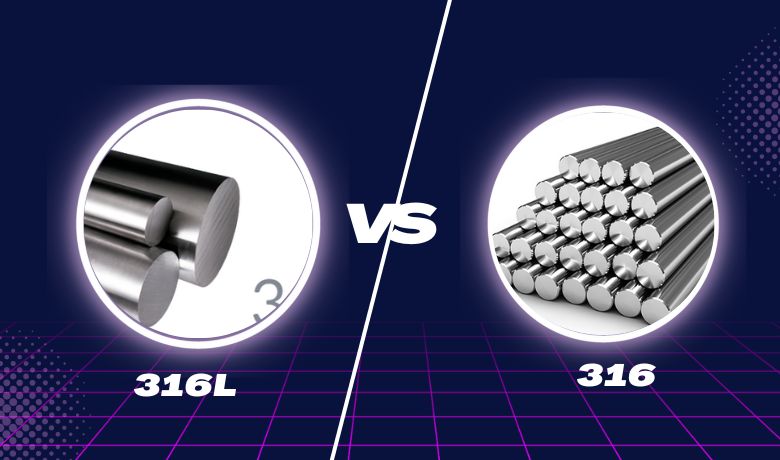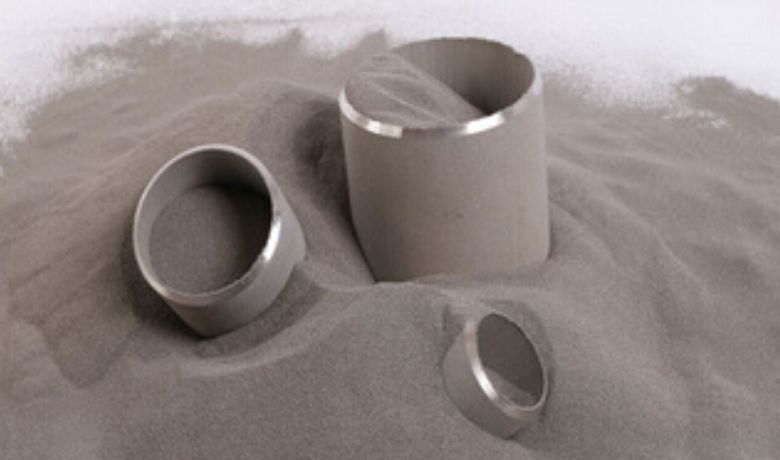
316 vs 316L Stainless Steel, Which is Better For Sintered Filter ?
1. Introduction
Sintered filters are a type of filtration device that use a porous material, such as stainless steel or bronze, to remove contaminants from liquids or gases.
One of the key factors to consider when selecting a sintered filter is the type of stainless steel used in its construction.
Two popular options are 316L and 316 stainless steel.
But which is better for sintered filters: 316L or 316 stainless steel?
In This blog post, We will compare and contrast the properties, applications, and pros and cons of these two types of stainless steel in sintered filters.
Hope it will be helpful for your to have a idea to choose better one for your filtration project or system in the future.
2. Overview of 316L and 316 Stainless Steel
316 and 316L stainless steel are both austenitic stainless steels that are known for their excellent corrosion resistance. They are both part of the 300 series of stainless steels, which are characterized by their high chromium content (16-20%) and nickel content (8-10%). This combination of chromium and nickel gives these steels their excellent corrosion resistance in a wide range of environments.
1. 316 Stainless Steel
316 stainless steel has a carbon content of 0.08% maximum. This makes it a good choice for applications where high strength and toughness are required. It is also resistant to corrosion in a variety of environments, including marine environments. However, 316 stainless steel is susceptible to intergranular corrosion (IGC) in the heat-affected zone (HAZ) of welds. This is a type of corrosion that can occur when the steel is heated to a temperature between its austenitizing and precipitation hardening temperatures.
2. 316L Stainless Steel
316L stainless steel has a carbon content of 0.03% maximum. This lower carbon content makes it more resistant to IGC than 316 stainless steel. It also makes it more weldable than 316 stainless steel. 316L stainless steel is also resistant to pitting and crevice corrosion, which are two types of localized corrosion that can occur in stainless steels. This makes it a good choice for applications where the steel will be exposed to chloride ions, such as seawater or chemicals.
316 and 316L stainless steel are both excellent choices for a wide variety of applications.
316L stainless steel is the better choice for applications where welding is required or where
there is a risk of IGC. 316 stainless steel is a good choice for applications where high
strength and toughness are required.
Here is a table summarizing the key differences between 316 and 316L stainless steel:
| Feature | 316 Stainless Steel | 316L Stainless Steel |
|---|---|---|
| Carbon content | 0.08% max | 0.03% max |
| Weldability | Good | Excellent |
| Intergranular corrosion resistance | Susceptible | Resistant |
| Pitting and crevice corrosion resistance | Good | Excellent |
| Applications | Architectural, food processing, chemical processing, marine | Chemical processing, marine, surgical implants, pharmaceutical, aerospace |
3. Applications of 316L and 316 Stainless Steel in Sintered Filters
Applications of 316L and 316 Stainless Steel in Sintered Filters Both 316L and 316 stainless steel are commonly used in sintered filters due to their corrosion resistance and strength. However, they have different applications based on their specific properties.
316L stainless steel is often used in sintered filters in corrosive environments, such as marine or chemical processing applications. It is also well-suited for use in food and beverage processing, as it is non-toxic and meets FDA standards.
316L stainless steel is commonly used in a wide variety of applications, including:
* Chemical processing equipment
* Marine applications
* Surgical implants
* Pharmaceutical equipment
* Aerospace applications
316 stainless steel is typically used in sintered filters that require high strength and durability, such as in construction or pharmaceutical applications. It is also often used in high-temperature environments, with a higher melting point than 316L stainless steel.
316 stainless steel is commonly used in a wide variety of applications, including:
* Architectural applications
* Food processing equipment
* Chemical processing equipment
* Marine applications
* Surgical implants
4. Pros and Cons of 316L and 316 Stainless Steel in Sintered Filters
Pros and Cons of 316L and 316 Stainless Steel in Sintered Filters Both 316L and 316 stainless steel have their unique advantages and disadvantages when used in sintered filters.
A: One of the main advantages of using 316L stainless steel in sintered filters is its corrosion resistance. It is well-suited for use in harsh environments, such as marine or chemical processing applications. It is also non-toxic and meets FDA standards, making it a good choice for food and beverage processing.
However, 316L stainless steel is not as strong or durable as 316 stainless steel and may not be suitable for high-stress applications. It also has a lower melting point, which may limit its use in high-temperature environments.
B: On the other hand, 316 stainless steel is known for its strength and durability, making it a good choice for high-stress applications. It also has a higher melting point, making it suitable for high-temperature environments.
However, 316 stainless steel is not as corrosion-resistant as 316L stainless steel and may not be the best choice for use in corrosive environments. It is also more expensive than 316L stainless steel, 316 stainless steel is known for its strength and durability, making it a good choice for use in high-stress applications and high-temperature environments.
When selecting a sintered filter, it is important to consider the specific requirements of your application, including the environment in which you will use the filter, the corrosion resistance required, and the strength and durability needed.
| Feature | 316 Stainless Steel | 316L Stainless Steel |
|---|---|---|
| Carbon content | 0.08% max | 0.03% max |
| Weldability | Good | Excellent |
| Intergranular corrosion resistance | Susceptible | Resistant |
| Pitting and crevice corrosion resistance | Good | Excellent |
| Applications | Architectural, food processing, chemical processing, marine | Chemical processing, marine, surgical implants, pharmaceutical, aerospace |
5. Maintenance and Care of Sintered Filters Made with 316L and 316 Stainless Steel
Maintenance and Care of Sintered Filters Made with 316L and 316 Stainless Steel
* Regular cleaning of sintered filters is essential to ensure their longevity and effectiveness.
* For 316L stainless steel filters, use mild detergent and warm water followed by a thorough rinse.
* For 316 stainless steel filters, a stronger cleaning solution may be needed, but caution should be used to avoid damaging the filter.
* Handle both sintered filters carefully to avoid damaging the porous material.
* Store sintered filters in a clean, dry environment to prevent contamination.
| Feature | 316L Stainless Steel | 316 Stainless Steel |
|---|---|---|
| Cleaning Solution | Mild detergent and warm water | Stronger cleaning solution |
| Cleaning Instructions | Rinse thoroughly with clean water | Use caution to avoid damaging the filter |
| Handling Instructions | Handle carefully to avoid damaging the porous material | Handle carefully to avoid damaging the porous material |
| Storage Instructions | Store in a clean, dry environment | Store in a clean, dry environment |
6. Cost Comparison of 316L and 316 Stainless Steel in Sintered Filters
Cost Comparison of 316L and 316 Stainless Steel in Sintered Filters In general, sintered filters made with 316L stainless steel are less expensive than those made with 316 stainless steel. It is due partly to the lower cost of 316L stainless steel and its lower strength and durability compared to 316 stainless steel.
Here, we list around price of 316L and 316 Stainless Steel Sintered Filters, You can use these prices as a reference,
Sure, welcome to contact HENGKO by email ka@hengko.com, or you can click the button as follow, to get the price list of sintered filters.

Here is a table comparing the cost of 316L and 316 stainless steel in sintered filters:
| Feature | 316L Stainless Steel | 316 Stainless Steel |
|---|---|---|
| Cost per filter | $40-$50 | $30-$40 |
| Filters per pack | 10 | 10 |
| Total cost per pack | $400-$500 | $300-$400 |
| Estimated lifetime | 5 years | 2 years |
| Cost per year | $80-$100 | $150-$200 |
| Overall Cost** | 20 Years | 20 Years |
| Overall Cost 316L | $1600-$2000 | $3000-$4000 |
| Overall Cost Saving | $1400-$2000 | $0 |
As you can see, 316L stainless steel filters are more expensive than 316 stainless steel filters. However, they also have a longer lifespan, so they can save you money in the long run. Additionally, 316L stainless steel filters are more resistant to corrosion, so they are a better choice for applications where the filters will be exposed to harsh chemicals.
Here is a breakdown of the cost savings:
* Initial cost savings: 316L stainless steel filters are 25% more expensive than 316 stainless steel filters. However, they also last 2.5 times longer, so you will save 50% on the cost of filters over their lifetime.
* Maintenance cost savings: 316L stainless steel filters are more resistant to corrosion, so they will require less maintenance than 316 stainless steel filters. This can save you money on labor and materials.
Overall, 316L stainless steel filters are a more cost-effective option than 316 stainless steel filters for most applications.
7. Conclusion
316L and 316 stainless steel has unique properties and are well-suited for different applications in sintered filters.
316L stainless steel is known for its corrosion resistance and is a good choice for use in corrosive environments and
food and beverage processing. 316 stainless steel, on the other hand, has a higher carbon content and is generally
stronger and more durable than 316L stainless steel. It is often used in high-stress environments, such as construction,
pharmaceuticals, and chemical processing.
Have Any More Questions and Interested for the 316L vs 316 Stainless Steel, You
are welcome to contact us by email ka@hengko.com, we will send back to you
asap within 24-Hours.
Post time: Jan-09-2023




